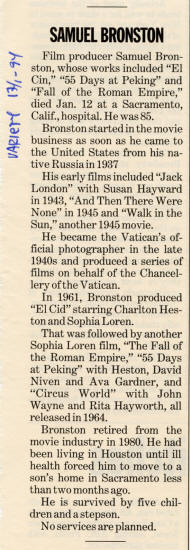Miramax Films Presents "El Cid" |
Read more at in70mm.com The 70mm Newsletter |
| Written by: Miramax Films, August 1993. Prepared for in70mm.com from vintage texts by Anders Olsson | Date: 13.01.2015 |
|
More in 70mm reading: “El Cid”: The North American Roadshow and 70mm Engagements Miramax Films Presents "El Cid" German Release of "El Cid" Super Technirama 70 History of Technirama Remembering Miklós Rózsa 70mm movies of Charlton Heston PDF: • "El Cid" Press Notes • "El Cid" for the projectionist |
"El Cid" cast & credits |
|
|
Directed by Anthony Mann. Associate producers Jaime Padres and Michael
Waszynski. screenplay by Frederic M. Frank and Philip Yordan; Photography,
Robert Krasker; editing, Robert Lawrence; art direction, Veniero Colasanti
and John Moore; musical score Miklos Rozsa. CAST Charlton Heston (Rodrigo Diaz (El Cid)), Sophia Loren (Chimene), Raf Vallon (Ordonez), Ralph Truman (King Ferdinand), Gary Raymond (Sancho), John Fraser (Alfonso), Genevieve Page (Urraca), Andrew Cruickshank (Gormaz), Michael Hordern (Don Diego), Gerard Tichy (King Ramilo), Christopher Rhodes (Don Martin), Hurd Hatfield (Ariaz), Massimo Serrato (Funez), Carlo Giustini (Bermudez), Douglas Wilmer (Moutamin), Frank Thring (Al Kadir), Herbert Lom (Ben Yussuf) |
|
"El Cid" Synopsis |
|
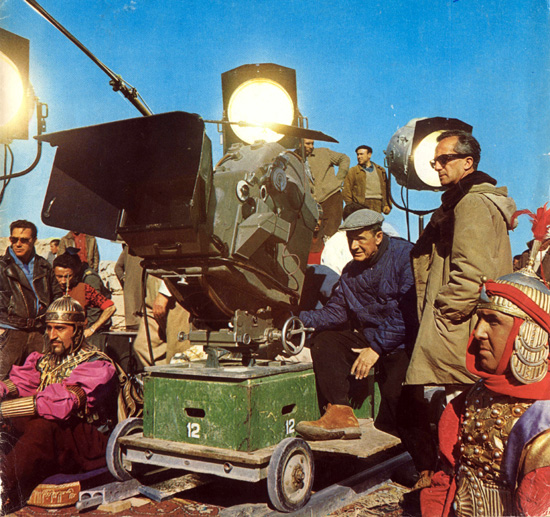 Photographing
"El Cid" in Technirama Photographing
"El Cid" in TechniramaEl Cid, (Charlton Heston) the 11th century warrior-hero, was born Rodrigo Diaz de Bivar, the only son of a Castilian nobleman. He became the visionary leader of his people, a knight who sought to unify the Christian kings in the north and their enemies, the Moorish Emirs in the south, against a fanatical invader from across the Mediterranean, Ben Yussuf (Herbert Lom), also a Moor, who threatened to engulf not only all of Spain, but the rest of Europe, as well. The story begins when the Moorish Emirs of Spain, spurred by the murderous Ben Yussuf of North Africa, raid and burn a Castilian border village. After a brief battle, the leaders are captured by the young warrior Rodrigo. Angry villagers demand the Moor's deaths but Rodrigo spares them in return for their promise never again to attack Castile. Impressed by his compassion and valor, one of the captured Emirs, Moutamin, honors Rodrigo with the name "El Cid," a name which means one who is both compassionate and a great warrior. The court of King Ferdinand (Ralph Truman) of Castile is not as deferential or sanguine. Rodrigo's rival, Count Ordonez (Raf Vallone), and Count Gormaz, the father of his beloved Chimene (Sophia Loren) and King Ferdinand's champion, accuse him of treason. Even Chimene, though deeply in love with Rodrigo, fails to understand his unprecedented act of charity towards the Moors. Only Don Diego, El Cid's father, comes to his defense, and is grievously insulted by Count Gormaz. Rodrigo travels to Gormaz's castle to beg an apology but the Count refuses. A duel ensues and Rodrigo kills Gormaz. Before he dies, the Count asks Chimene, his daughter, to avenge him. Bereaved and conflicted because of her love for Rodrigo, Chimene petitions the King for the court's official revenge. Her appeal is interrupted, however, when King Ramilo of Aragon challenges Ferdinand for the possession of the border city of Calahorra. Rodrigo overhears the challenge and convinces Ferdinand to let him fight the Champion of Aragon for Calahorra. Thus according to the custom of trial by combat, God would judge his guilt or innocence. Chimene presents her colors to Rodrigo's adversary and asks him to avenge her father's death. Ferdinand's daughter the Infanta Urraca (Genevieve Page), gives her colors to Rodrigo, to taunt Chimene. |
|
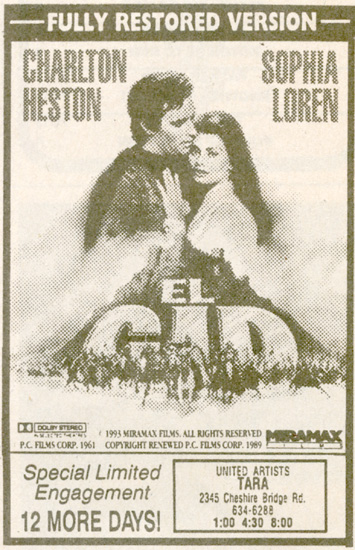 Mounted on his white stallion Babieca, El Cid rides out to meet the
challenge. After a tremendous, violent contest of strength and will, Rodrigo
is victorious. Proudly he claims Calahorra and presents the city to
Ferdinand, who names him the new Champion of Castile. Mounted on his white stallion Babieca, El Cid rides out to meet the
challenge. After a tremendous, violent contest of strength and will, Rodrigo
is victorious. Proudly he claims Calahorra and presents the city to
Ferdinand, who names him the new Champion of Castile.Meanwhile, Rodrigo's rival Ordonez visits Chimene in the chapel of her castle, where he finds her in mourning for her father. He confesses his love for her and promises to avenge her father's death by killing El Cid. Emotionally torn, she pledges herself to him in return. El Cid starts out on a mission to exact tribute from the Moorish kingdoms to the south. He is accompanied by the treacherous Ordonez, who plots El Cid's demise. Suddenly, the group is ambushed, but help comes from El Cid's old friend Moutamin, the Moor. At the end of the attack, Count Arias lies mortally wounded and Ordonez is exposed. Ordonez taunts El Cid by revealing that Chimene has offered herself as the prize for killing him. In spite of this information, El Cid still wants to marry Chimene and asks King Ferdinand to order the wedding. Chimene accepts the king's demand but remains cold and uncommunicative during the ceremony. On the bridal night, she tells El Cid that her marriage will become her means of revenge. The next day, she enters a convent, vowing that she will never live as wife to her father's killer. King Ferdinand dies suddenly. His ambiguous last words divide the kingdom between his two sons, Sancho and Alfonso, and his daughter Urraca. Sancho and Alfonso quarrel over the throne and Sancho claiming the eldest son's right to succession, orders his younger brother into exile. Alfonso, aided by El Cid, takes refuge in his sister's walled city of Zamora. El Cid tries to reconcile the brothers, to no avail as the enemy Ben Yussuf schemes at the coastal city of Valencia to make the most of the fraternal quarrel between the Christian Kings. Sancho lays siege to Zamora, demanding that his sister, Urraca surrender Alfonso. He arranges the assassination of Sancho, making it appear as though his rival brother killed him. Alfonso's magnificent coronation at the Burgos cathedral of Santa Gadea is marred by El Cid's determination to make him swear before the assembled nobles that he is innocent of his brother's death. Standing alone in the cathedral, El Cid forces Alfonso, humiliated and furious, to swear his innocence in front of the Castilian nobles. In return, Alfonso's first official decree as king is to banish El Cid. Stripped of his honors and possession, El Cid leaves his homeland, doomed to wander through the hostile Moorish kingdoms to the south of Castile. On a lonely road near the border, he is met by Chimene, who has left the convent after learning of the plan and realizing the depth of her husband's rare character. She begs his forgiveness and asks to join him in exile. |
|
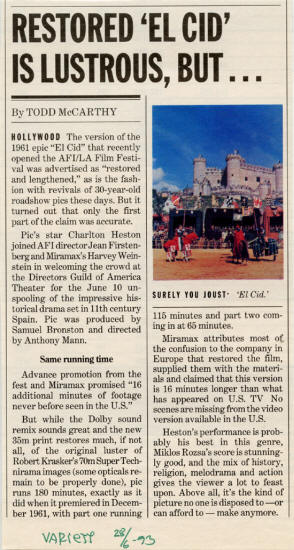 Refused lodgings by the frightened townspeople, El Cid and Chimene find
refuge in a farmer's stable. They share a night of passion and he asks God
to watch over her especially now that they are truly "man and wife". It is
too dangerous for Chimene to travel with him and his little band of
followers into Moorish territory, so El Cid leaves her at the convent and
rides off into uncertainty. Refused lodgings by the frightened townspeople, El Cid and Chimene find
refuge in a farmer's stable. They share a night of passion and he asks God
to watch over her especially now that they are truly "man and wife". It is
too dangerous for Chimene to travel with him and his little band of
followers into Moorish territory, so El Cid leaves her at the convent and
rides off into uncertainty.During the next few years, El Cid becomes a triumphant warrior, fighting under his own banner, winning many friends among the Spanish Moors. Ben Yussuf is also busy, landing his troops on Spanish soil and challenging King Alfonso to meet him in battle. Alfonso recalls El Cid from exile to help defend the kingdom, but he refuses the aid of El Cid's Moorish allies. El Cid returns to his men as Alfonso hurls curses after him. El Cid stops at the convent to visit Chimene and their twin daughters whom he has never seen. Weary of battle, he nevertheless tell her the importance of winning one last battle at Valencia before they can finally live together in peace. The battle between King Alfonso and Ben Yussuf goes very badly for the Christian king. In retreat, he finds refuge at Chimene's convent. Full of hatred for El Cid, he imprisons Chimene and her children. The city of Valencia is about to fall to El Cid when he learns of Alfonso's vengeful deed. Wildly distraught and furious, he asks his men to join him in an expedition to free his family. Chimene, however, hearing that he plans to abandon his mission at Valencia, induces Rodrigo's old rival, Ordonez to defy Alfonso and take her to the camp of El Cid outside the gates of the besieged city. The next morning, the legions of El Cid march to the gates of Valencia with war machines, catapults and scaling ladders. In lieu of these weapons of death, El Cid comes up with a last minute, ingenious strategy: he uses the catapults to rocket food over the walls. As expected, the starving townspeople revolt against Al Kadir, the Moor who rules the city, and open the gates. In triumph, El Cid and his men parade through the city to the hilltop palace of the deposed Moorish ruler and El Cid is presented the crown of Valencia. Deeply touched, he accepts it in the name of King Alfonso. This act of fealty moves Alfonso and he revolts against his sister's domination reconciling with El Cid. Inside the walls of Valencia, El Cid watches as Ben Yussuf's hordes of black-robed warriors set up their camp on the beach. Realizing that the city cannot long withstand another siege, El Cid plans a surprise attack. Leading his knights into battle, El Cid is hit in the chest by an arrow. Barely able to hold his seat on Babieca, he rides back to the city's gates. Before appearing, he breaks off the arrow shaft and hides his wound from the cheering crowd. Attended by Chimene and his knights, the wounded El Cid realizes that he must lead his men in one final attack against the enemy. He makes Chimene promise that, alive or dead, he will be at the head of his troops in battle the next morning. King Alfonso arrives to join him and El Cid rejoices that at last he will be riding at the side of his king, who he feels has learned what it takes to rule a united Spain. At dawn, keeping his word, El Cid rides out of the gates of Valencia, firmly mounted on his white charger. The Moors, who have heard rumors of his death, panic at the sight of the seemingly invincible warrior and flee toward their ships, leaving Valencia in the hands of Alfonso and a firmly united Spain. |
|
The Making of "El Cid" |
|
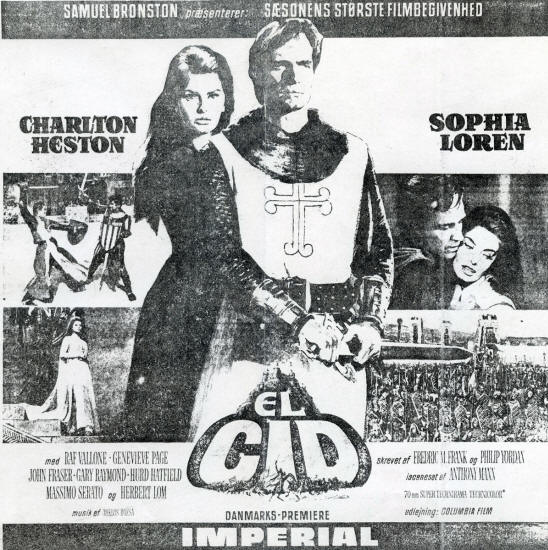 Premiere
advert from Copenhagen. Click the image to see the enlargement Premiere
advert from Copenhagen. Click the image to see the enlargementIn 1961, producer Samuel Bronston could truly be considered an epic filmmaker, with the release of two colossal productions- "King of Kings," the story of Christ and "El Cid." The latter was perhaps even more daring and monumental than the former. Starring Charlton Heston and Sophia Loren, and directed by Anthony Mann, the film is a lavish saga of romance and adventure, chronicling the life of the great 11th century champion who sought to unite Spain's disparate, warring religious factions under a single crown. The story was one never before told on film, an undertaking that ultimately required a year of pre-production and 8 months of shooting. "El Cid" is a feature with a history as rich and spectacular as any of its hero's famed exploits. The film has a message of religious tolerance which applies even today. "El Cid" is a Miramax Films and Martin Scorsese presentation of a Samuel Bronston production in association with Dear Film productions, starring Charlton Heston and Sophia Loren. "El Cid" also stars Raf Vallone and Genevieve Page and co-stars John Fraser, Gery Raymond, Hurd Hatfield, Massimo Serato and Herbert Lom. Directed by Anthony Mann and produced by Samuel Bronston; the associate producers are Michael Waszynski & Jaime Padres. "El Cid" is written by Frederic M. Frank and Phillip Yordan. Music is by Miklos Rozsa and director of photography is Robert Krasker. Veniero Colasanti & John Moore serve as set decorators, production and costume designers and Robert Lawrence is the editor. "El Cid" is based on the legendary life of Rodrigo de Bivar, a Castilian knight in the Spanish court of King Ferdinand, called El Cid by Ferdinand's enemies, the Moors. The name came from the Arabic word meaning leader and it was a mark of their respect for his virtue as a merciful and wise lord as well as his prowess as a warrior. During the period in which the film takes place, rival feudal kingdoms that would become Spain, assailed by the hostile Moors, had become fragmented by enmity and intrigues. Only El Cid envisioned a united Spain and a future of conciliation and tolerance. |
|
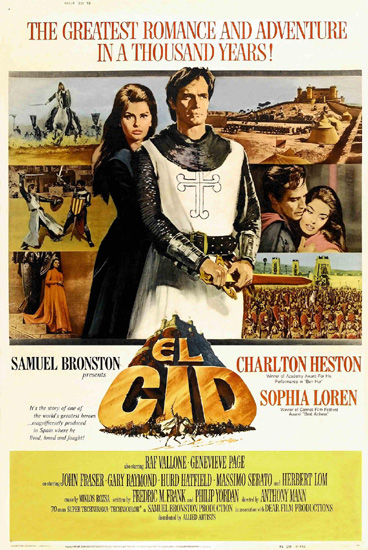 The
famous knight has captivated artists for centuries. Statues of El Cid grace
many cities in his native Spain and the famed Prado Museum boasts several
paintings of his battlefield exploits. During his lifetime, ballads extolled
his glory and his love for the Lady Chimene. In the 12th century, his life
was chronicled in the classic "Poema" and in the 16th century, Gillen de
Castro wrote a drama based on El Cid's adventures. By the 17th century, the
French dramatist, Corneille had transformed the story into the tragedy
entitled "Le Cid" and Washington Irving later offered his interpretation in
"The Alhambra." Three operas have been composed about his life by Sacchini,
Cornelius and Massenet. Until Samuel Bronston's production, however, the
timeless story had never been committed to film. The
famous knight has captivated artists for centuries. Statues of El Cid grace
many cities in his native Spain and the famed Prado Museum boasts several
paintings of his battlefield exploits. During his lifetime, ballads extolled
his glory and his love for the Lady Chimene. In the 12th century, his life
was chronicled in the classic "Poema" and in the 16th century, Gillen de
Castro wrote a drama based on El Cid's adventures. By the 17th century, the
French dramatist, Corneille had transformed the story into the tragedy
entitled "Le Cid" and Washington Irving later offered his interpretation in
"The Alhambra." Three operas have been composed about his life by Sacchini,
Cornelius and Massenet. Until Samuel Bronston's production, however, the
timeless story had never been committed to film.
Producer Samuel Bronston saw the story of El Cid as "something considerably more than spectacle," but Bronston was quite familiar with the spectacular. He also produced the ambitious "King of Kings," chronicling the life of Christ. Both productions were lauded for their romance, adventure, pageantry and scope, but in "El Cid," Bronston also saw a powerful saga of one man's struggle for justice and peace. Raised in Paris and educated at the Sorbonne, Bronston produced the biographical film "Jack London" and several Jack London stories before moving to Madrid to start his own production company. He produced John Faro's "John Paul Jones," starring Robert Stack and Bette Davis and moved on to his two epic films. Bronston seemed perfectly cast as the producer of "El Cid": his company was based in Spain, he was classically educated and had experience shooting the detailed as well as the epic, having shot a documentary of the great and lavish art treasures of the Vatican, as well as producing "King of Kings." Pre-production for "El Cid" lasted for more than a year before cameras actually rolled. Bronston insisted on authenticity- "I wanted every scene to be real, not just look real." To that end, he hired Dr. Gonzalo Menendes Pidal, professor of Romance Literature at Madrid University, as the film's historic and literary advisor and, under his guidance, thousands of pieces of court finery, uniforms, armor, household goods and artifacts were created for the film. Art directors Veniero Colasanti and John Moore created hundreds of magnificent costumes and heraldic accessories to depict the pageantry of the court of Castile. Velvet, lace, silk and satin came from the greatest fabric houses in the world to recreate the rich brocades and damasks fashionable in the 11th century. The famed Garrido brothers, historic armorers from Toledo, provided the traditional swords, lances and armor for the knights, foot soldiers and Moors. |
|
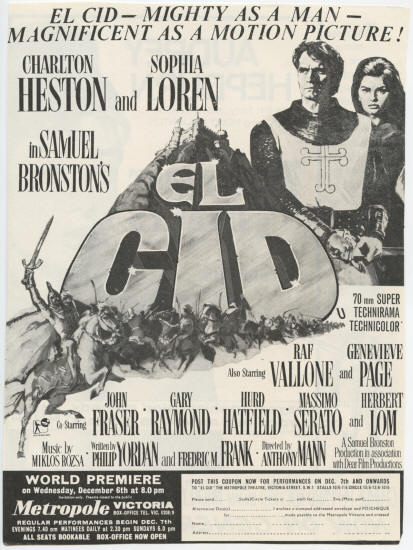 World
Premiere in London. Click the advert to see enlargement World
Premiere in London. Click the advert to see enlargementEven the music was based on 11th and 12th century melodies, composed by Academy Award-winner Miklos Rosza, who was known for scoring such historical classics as "Ben Hur," "Quo Vadis," "Julius Caesar," "Ivanhoe," "Knights of the Round Table" and Bronston's "King of Kings." In Pidal's personal library, Rosza discovered an excellent collection of medieval music and, at Pidal's suggestion, he also visited the library at El Escorial, Spain's great monastery where the cantigas of the 11th and 12th centuries had been preserved in original manuscript form. He also found the religious music of the Mozarabs of Spain, the Christians who lived under Moslem rule. Location scouts scoured Spain, looking for the actual historic sites where El Cid's adventures took place. During the eight months that it took to film "El Cid," the company traveled more than 3,500 miles through the back country of Spain. The shoot was as colossal as El Cid's legend. For instance, the ancient walled city of Pensicola on the seacoast doubled for El Cid's Valencia. A production crew of 348 technicians reconstructed the wall of the town and castle to appear as they did when El Cid threw the fanatic African Moors into the sea. Director Anthony Mann blocked battle movements for a month, using 1700 Spanish army troops, 500 mounted riders of Madrid's Municipal Honor Guard and hundreds of the province's locals as warriors. Fifteen giant war machines used by the Christian knights were reconstructed from historical drawings and 35 boats were decorated with the Moorish fleet's battle ornaments. Many of the major scenes were shot against perfectly preserved medieval castles. Indeed, only one major set had to be built, for the wedding of El Cid and his beloved Chimene. The Cathedral at Burgos, where they were actually wed, retained little of its 11th century architecture, as it had been altered and embellished in the 16th century. Bronston ordered a $40,000 replica of the original to be built for this scene, as well as for the coronation of King Alphonso. "El Cid" was released in December of 1961 and ran in special roadshow engagements through 1962 to great commercial and critical success and went on to earn two Oscar nominations. "El Cid" was one of many monumental projects for Bronston. He went on to produce Nicholas Ray's "The 55 Days in Peking," with Ava Gardener, Charlton Heston and David Niven and Henry Hathaway's "Circus World," starring John Wayne, Claudia Cardinale and Rita Hayworth. Bronston again worked with Anthony Mann and Sophia Loren, producing Mann's "The Fall of the Roman Empire," also starring Alec Guiness, Omar Sharif and James Mason. The film was to be "the most spectacular mega-production ever." It turned out to be a colossal failure and ruined the Bronston empire. |
|
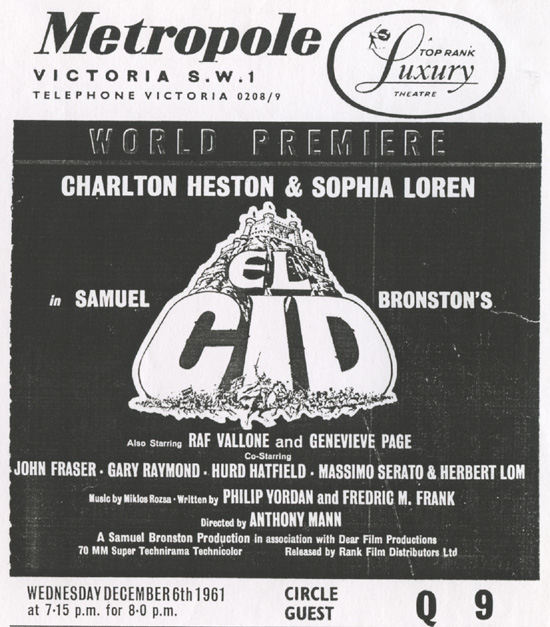 In the early 1990s, two French companies, Argos Films, headed by Jacques
Rerat and Les Films 26, headed by Jean-Paul de Vidas, teamed up to restore
and re-release their first Bronston film: "El Cid." In the early 1990s, two French companies, Argos Films, headed by Jacques
Rerat and Les Films 26, headed by Jean-Paul de Vidas, teamed up to restore
and re-release their first Bronston film: "El Cid."Piecing together a film which was released 30 years ago, proved to be as epic an undertaking as the actual production. The film and all the original elements had been placed in storage in London and a daunting amount of material awaited the new distributors. Following the example of the recently restored "Lawrence of Arabia," Rerat and de Vidas hoped to re-record the film in Dolby Stereo to make it technologically compatible with modern movie theaters. To accomplish this required more detective work. In order to re-mix the film, they had to find the original magnetic soundtracks. After a bit of sleuthing, they discovered the missing soundtracks in the possession of a London collector, who handed them right over. Miraculously, they were in perfect condition. Moreover, the track included the musical sequence from the overture, the intermission, the opening of the second half and the closing music that appeared after the end credits in a fashion typical of these grand scale productions. The re-mix finally began at the Studios de La Garenne Colombes, followed by a transfer of the new sound and an optical recording at the Eclair Laboratories. Since the only Technirama negative was in extremely poor condition, the restorers used as their source material the original yellow, cyan and magenta Technicolor production masters. From these master a new triple printed internegative was struck. Miramax acquired this restored version of "El Cid" for a North American distribution in early 1993. At the point of the acquisition the company decided that additional work was still necessary and returned again to the original production master reprinting frame by frame certain opticals which needed extra work. Their work included color corrections as well as replacing damaged frames in the feature internegative. |
|
Charlton Heston Biography |
|
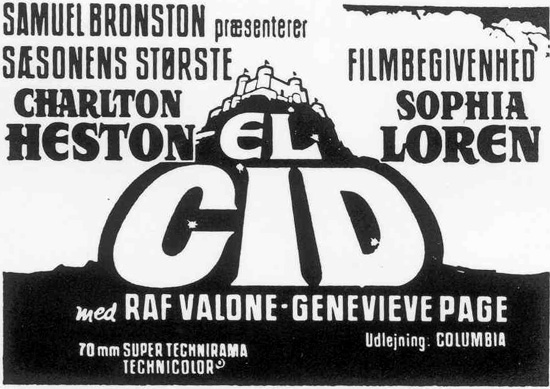 Academy Award-winning actor Charlton Heston has delighted audiences and
critics for nearly 50 years, in a variety of television, radio, stage and
film productions. Especially known for his portrayals of larger-than-life
figures, Heston's roles range from Moses to John the Baptist to Ben Hur. Academy Award-winning actor Charlton Heston has delighted audiences and
critics for nearly 50 years, in a variety of television, radio, stage and
film productions. Especially known for his portrayals of larger-than-life
figures, Heston's roles range from Moses to John the Baptist to Ben Hur.Born in Evanston, Illinois, Heston spent his early years in St. Helen, Michigan, where he gained his first acting experiences by performing the stories his father read to him. After graduating high school, he won an acting scholarship to Northwestern University's Speech School. He majored in drama and starred in many of the plays presented by the school's critically-acclaimed theater program. During this time, he earned part of his tuition by acting in daytime radio shows in nearby Chicago. Heston and his wife Lydia, whom he met at Northwestern, moved to New York City after his three-year stint in the Air Force. While he made the rounds of all the casting offices, his wife supported them through modeling. Ultimately, both Hestons became co-directors and performers at the Thomas Wolfe Memorial Theater in Asheville, North Carolina. They arrived intending to do one play and stayed for six, including "The State of the Union," "The Glass Menagerie," and "Kiss and Tell." In 1948, they returned to New York where Heston made his Broadway debut as a member of Katharine Cornell's "Antony and Cleopatra," playing a number of roles during the play's long and successful run. |
|
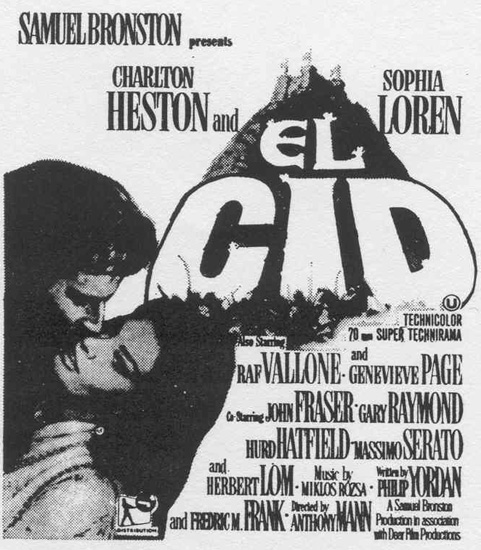 Heston became one of the first Broadway actors to achieve success in early
television, appearing in a number of the famed "Studio One" productions. It
was his portrayal of Marc Antony in David Bradley's widely acclaimed 16mm
version of "Julius Caesar" that brought him to the attention of Hollywood.
After Hall Wallis saw the film, he brought Heston to California to play the
leading role in a gangster film entitled "Dark City," released in 1950. Heston became one of the first Broadway actors to achieve success in early
television, appearing in a number of the famed "Studio One" productions. It
was his portrayal of Marc Antony in David Bradley's widely acclaimed 16mm
version of "Julius Caesar" that brought him to the attention of Hollywood.
After Hall Wallis saw the film, he brought Heston to California to play the
leading role in a gangster film entitled "Dark City," released in 1950.Cecil B. DeMille then signed him to appear as the ringmaster in "The Greatest Show On Earth." DeMille also directed Heston in the sweeping Biblical epic "The Ten Commandments." Other credits include "The Savage," "Ruby Gentry," "The President's Lady," "Pony Express," "Arrowhead," "Bad For Each Other," "The Naked Jungle," "Secret of the Incas" "The Far Horizons," "The Private War of Major Benson" and "Lucy Gallant," all shot between 1952 and 1955. In 1959, Heston won the Academy Award for Best Actor for his role in "Ben Hur" and has won numerous overseas equivalents of the Oscar, including Germany's highest honor, the Bambi; Italy's David di Donatello and Belgium's "Uilenspiegel," which he has garnered three times. Heston's prolific film career includes such credits as another Samuel Bronston film, "55 Days At Peking," "The Greatest Story Ever Told," "The Agony and the Ecstasy," "The Big Country," "The War Lord," Khartoum," "Will Penny," "The Planet of the Apes," "Airport '75," "The Three Musketeers" and its sequel, "The Four Musketeers," "Earthquake," "The Mountain Men" and "The Awakening," among many others. He directed the film adaptation of "Antony and Cleopatra," in which he also starred and starred and directed the film "Mother Lode." On television, he starred in such television movies as "Nairobi Affair," "Proud Men," "A Man For All Seasons," which he also directed, "Original Sin," "Treasure Island" and "The Little Kidnappers." Heston's additional stage credits include "MacBeth," "A Man For all Seasons" and Arthur Miller's "The Crucible." Politically active, Heston has made a number of overseas tours under the State Department's Cultural Presentation Program. He has served as a United States delegate to the Berlin Film Festival, visited troops during the Vietnam War three times and has served on the National Council of the Arts. In 1993, he was named as CARE's special envoy to Somalia. Additionally, Heston served six terms as president of the Screen Actors Guild. |
|
Sophia Loren Biography |
|
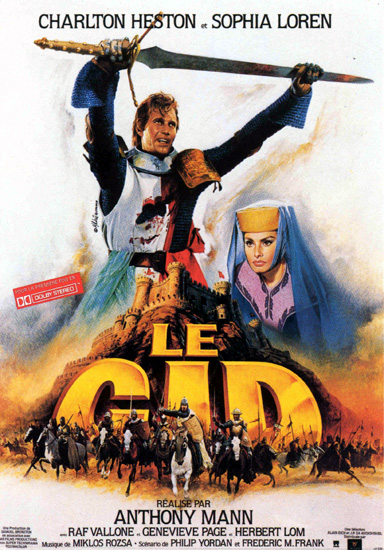 International screen star Sophia Loren was described by the Motion Picture
Academy in 1991 As "One of the genuine treasures of world cinema." Her
career spans 60 films, starting with her debut as an extra in "Quo Vadis,"
starring Charlton Heston, in 1949. International screen star Sophia Loren was described by the Motion Picture
Academy in 1991 As "One of the genuine treasures of world cinema." Her
career spans 60 films, starting with her debut as an extra in "Quo Vadis,"
starring Charlton Heston, in 1949.The former Sophia Lazzaro was born in Naples, a depressed war-weary city, first chafing under Mussolini's dictatorship and later under the sociopolitical netherworld of Allied occupation. She eventually moved to Rome with her family, supporting her mother and younger sister as a model and actress in the fumetti, photo soap operas that ran in papers like comic strips. The woman who would become a symbol of glamour and beauty was not considered conventionally pretty at the time, however, and her future in films looked bleak. Loren persisted and one night, she and a group of actor friends encountered a contest to crown Miss Rome at a nightclub. The jury featured several movie power-brokers, including producer Carlo Ponti, so Loren entered the contest. She finished second but won the admiration and aid of Ponti, who would later marry her. Ponti screen-tested his young protégé and re-christened her Sophia Loren. Success did not come immediately and she continued to accept bit parts, attracting some attention for her appearance in "Africa Beneath the Sea," which called for a comely swimmer. Only after she won the part did she reveal that she couldn't swim. Soon after, Loren won her first major role, in the film version of "Aida," which led to a starring role in Vittorio De Sica's "Gold of Naples" (1953). Ponti cast her as the lead in his movie "Woman of the River" (1954) and subsequently introduced her to American audiences with her starring role opposite Alan Ladd in "The Boy On The Dolphin." An underwater adventure story set in Greece, Loren, emerging dripping wet in a cotton dress from the Aegean sea, became a sensation. In 1958, Loren arrived in Hollywood and, capitalizing on her exotic looks and sensuality, she starred in such films as "Desire Under The Elms," "The Pride and the Passion," "Legend of the Lost" and "Houseboat," among others. in 1959 Ponti took control of her career and began producing films that emphasized her acting ability as well as her figure. "That Kind of Woman," opposite Tab Hunter, and "Black Orchid," opposite Anthony Quinn, were two such movies. She won the Best Actress Award at the Venice Film Festival for her performance in the latter feature. Other credits include "Heller in Pink Tights," "A Breath of Scandal," "It Started in Naples," "The Millionairess" and "Arabesque." In 1961, Loren returned to Italy and won the Academy Award for Best Actress for her performance in "Two Women," the only artist ever to earn such an Oscar in this category for work in a foreign language film. Hollywood productions continued to come to her, including "The Fall of the Roman Empire." She also starred in such Italian features as "Yesterday, Today and Tomorrow," "Sunflower" and "Marriage Italian Style," which earned her a second Academy Award nomination for Best Actress. Loren transcended her early roles as the sultry slave girl to become one of the world's most respected and well-loved actresses. In 1991, Loren received an honorary Oscar recognizing her substantial body of work and in 1992, she became the United Nations' Goodwill Ambassador for the world's refugees. |
|
Anthony Mann Biography |
|
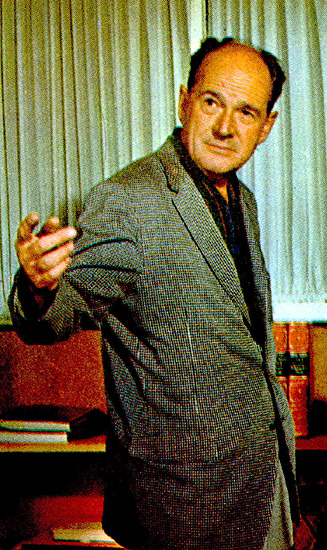 Director
Anthony Mann as pictured in the roadshow souvenir program, 1962 Director
Anthony Mann as pictured in the roadshow souvenir program, 1962Director Anthony Mann began his career as a stage actor and theater manager. Raised in New York, he left high school at age 16, working nights for Westinghouse Electric so that he could pursue his acting during the day. He won a few minor roles, but worked extensively as a stage manager in the theater, beginning as an assistant and eventually working as general stage manager for the Theater Group. Soon, Mann had given up acting and stage managing for directing. He directed such Broadway plays as Christopher Morley's "Thunder on the Left," "So Proudly We Hail," "New Faces" and "Swing Your Lady." His first job in Hollywood was directing the screen tests for "Gone With The Wind." That stint led to his first screen credit, "Mr. Broadway" for Paramount Pictures. He went on to direct such pictures as "T-Men," "The Furies," "The Glen Miller Story," "The Far Country," "Strategic Air Command" and "God's Little Acre." He also established himself in the western genre, earning the moniker "the dean of the sagebrush saga" for such films as "Winchester 73," "Man From Laramie," "Man of the West" and "Cimarron." In 1964, Mann again worked with producer Samuel Bronston and Sophia Loren, directing her in "The Fall of the Roman Empire" and went on to direct "The Heroes of Telemark". He died in 1968 during the filming of his last movie "A Dandy in Aspic". |
|
Samuel Bronston Biography |
|
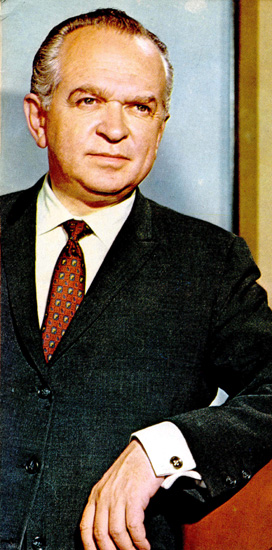 Producer Samuel Bronston
as pictured in the roadshow souvenir program, 1962 Producer Samuel Bronston
as pictured in the roadshow souvenir program, 1962Producer Samuel Bronston emerged as the impresario of the epic film in 1961, with the release of "El Cid," the story of a visionary knight, and "King of Kings," chronicling the life of Christ. Raised in Paris and educated at the Sorbonne, Bronston worked in production for MGM and United Artists after graduation. His career as a producer began in earnest after meeting with the widow of author of Jack London in Paris. This association led to the biographical film "Jack London" and the screen adaptations of London's "Martin Eden" and "Walk in the Sun." Bronston also produced a documentary covering the great art treasures of the Vatican before moving to Madrid in 1958 to set up his own production company. He went on to produce John Farrow's "John Paul Jones," starring Robert Stack and Bette Davis before moving on to his epic productions. He also produced "55 Days in Peking," starring Charlton Heston and Ava Gardner, "Circus World" and Anthony Mann's "Fall of the Roman Empire," another sweeping historical film starring, among others, Sophia Loren. |
|
Attention projectionist |
|
|
|
|
| Go: back - top - back issues - news index Updated 22-01-25 |

 "EL CID is one of the greatest epic films ever
made. Anthony Mann's sense of composition, his use of space, and his
graceful camera movements bring to life an ancient tapestry where the
transformation of an ordinary man into a legend becomes almost a mystical
experience."
"EL CID is one of the greatest epic films ever
made. Anthony Mann's sense of composition, his use of space, and his
graceful camera movements bring to life an ancient tapestry where the
transformation of an ordinary man into a legend becomes almost a mystical
experience."